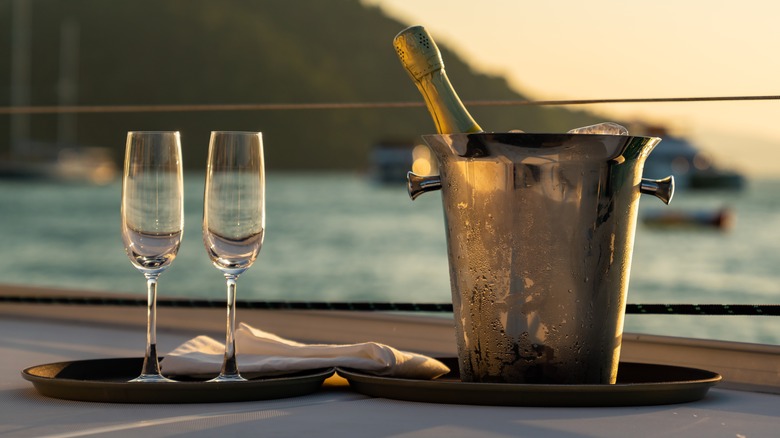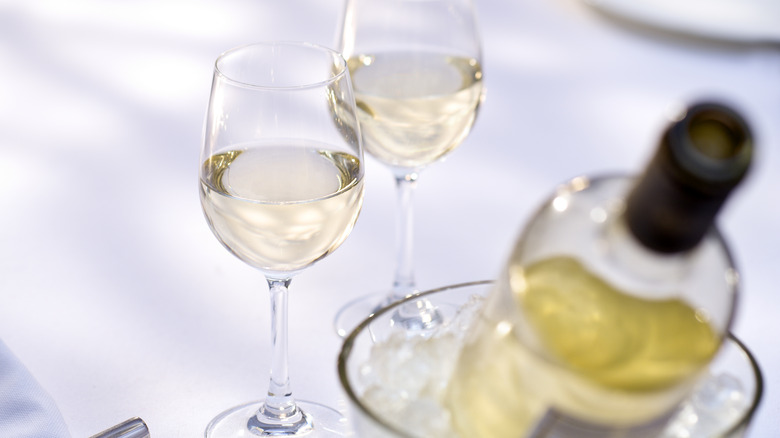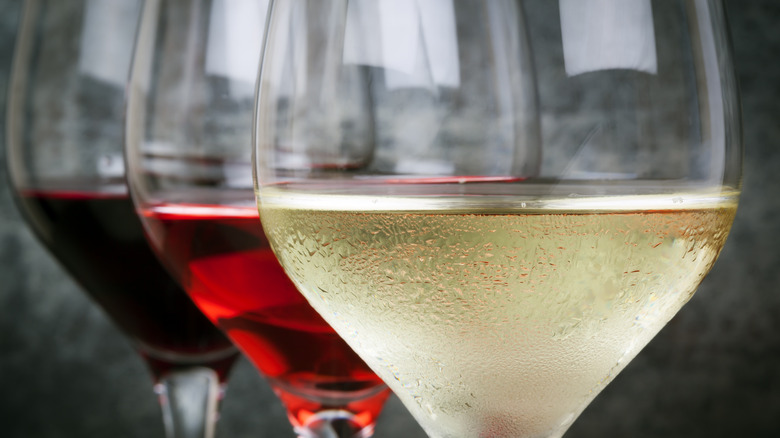The Mistake Almost Everyone Makes When Chilling Wine
How many times have you grabbed a bottle of wine, reached for that trusty bucket or cooler, tossed in a few ice cubes and perhaps some cold water, and then popped in the bottle? While it's a mistake that's all too common, it turns out that this simple faux pas is robbing us all of fully enjoying the flavors of our favorite wines.
Master Sommelier June Rodil told Food & Wine that the chilling mistake is one of her biggest pet peeves, noting that if you put the ice in the bucket first and lay the wine bottle on top, "the bottles will just lie on top of the ice, and nothing will happen." Instead, you should "Put the bottle in first, top it with ice and water so it's more or less submerged, and you're good to go." This method allows the cold water or ice to come in contact with a larger area of the bottle, chilling it more quickly and efficiently.
But that's not all there is to understand about properly chilling wine. As you might know, not all wines are created equal when it comes to temperature — it's why you serve sparkling wine ice cold and red wine (contrary to popular belief) slightly cooler than room temperature.
If that's news to you, then you'll want to learn about the ideal average temperature for different wine varieties. There are also helpful tips and tricks to help you avoid the common pitfalls of chilling wine bottles at home.
Why do you need to chill wine?
Paola Embry, award-winning wine director at Wrigley Mansion in Phoenix, explained to VinePair that when you chill a wine, "the flavors will become focused, the alcohol will not be as evident, and the structure will be tighter." Basically, when you serve wine at the right temperature, it allows all the aromas and flavors of the wine to reveal themselves.
Whites that are too warm can taste heavy and flat, while reds that are too cold can be bitter and harsh. Additionally, wines that are served too warm can end up tasting alcoholic and unbalanced, while those that are served too cold may seem dull or still. By ensuring that your wine is served at its ideal temperature, you'll get the most out of each sip.
However, you don't want to chill any wine, white, red, or rosé, for longer than needed, as Zwann Grays, wine director at Olmsted in Brooklyn, told Punch. "With whites, that cold temperature becomes a mask over the wine; the cold steals the soul of what the wine can express, the voluptuousness of what it can be," she said.
Aside from putting the wine in the bucket first before adding ice or cold water, it's also important to add salt to the mix if you're trying to chill a bottle quickly, as it helps bring the freezing point down even more.
Ideal serving temperatures
Sparkling wines should be chilled to the coldest temperatures to ensure the carbon dioxide stays trapped in the liquid, responsible for the delightful bubbles. Chill these wines (properly, as you've just learned how to do) between 38 to 45 degrees Fahrenheit. Fuller-bodied white wines like chardonnay are at their best between 50 to 60 degrees Fahrenheit. At this temperature range, their rich, bold flavors can fully express themselves.
For Brent Kroll, owner and sommelier at Maxwell Park wine bar in Washington, D.C., it's important to further segment white wines by variety for proper chilling. You'll find Maxwell Park white wines chilled in three different categories: light, crisp white wines are chilled at 40 degrees Fahrenheit, medium-bodied white wines at 45 degrees, and fuller-bodied white wines, like Rieslings, and even some red and orange varieties, at 50 degrees.
Red wines, on the other hand, are best served slightly cooler than room temperature, usually in the range of 55 to 65 degrees Fahrenheit. At this temperature, the tannins in the wine don't overpower the other flavors, allowing the fruit and various subtle notes to come forward.
Don't get too caught up in the specifics of temperature, though. There's some wiggle room here (even when storing wine). As Athénaïs de Béru of Château de Béru in Chablis told Punch, "It's all about the balance point of each and every wine and their ability to express their own potential, the best way."


